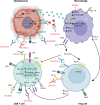Challenges in glioblastoma immunotherapy: mechanisms of resistance and therapeutic approaches to overcome them
- PMID: 35662275
- PMCID: PMC9470562
- DOI: 10.1038/s41416-022-01864-w
Challenges in glioblastoma immunotherapy: mechanisms of resistance and therapeutic approaches to overcome them
Abstract
Glioblastoma is the most common and aggressive primary malignant brain tumour. The prognosis of patients with glioblastoma is poor, and their overall survival averages at 1 year, despite advances made in cancer therapy. The emergence of immunotherapy, a strategy that targets the natural mechanisms of immune evasion by cancerous cells, has revolutionised the treatment of melanoma, lung cancer and other solid tumours; however, immunotherapy failed to improve the prognosis of patients with glioblastoma. This is attributed to the fact that glioblastoma is endowed with numerous mechanisms of resistance that include the intrinsic resistance, which refers to the location of the tumour within the brain and the nature of the blood-brain barrier, as well as the adaptive and acquired resistance that result from the tumour heterogeneity and its immunosuppressive microenvironment. Glioblastoma is notorious for its inter and intratumoral heterogeneity, which, coupled with its spatial and temporal evolution, limits its immunogenicity. In addition, the tumour microenvironment is enriched with immunosuppressive cells and molecules that hinder the reactivity of cytotoxic immune cells and the success of immunotherapies. In this article, we review the mechanisms of resistance of glioblastoma to immunotherapy and discuss treatment strategies to overcome them worthy of further exploration.
© 2022. The Author(s), under exclusive licence to Springer Nature Limited.
Conflict of interest statement
The authors declare no competing interests.
Figures

References
Publication types
MeSH terms
Substances
LinkOut - more resources
Full Text Sources
Other Literature Sources
Medical

